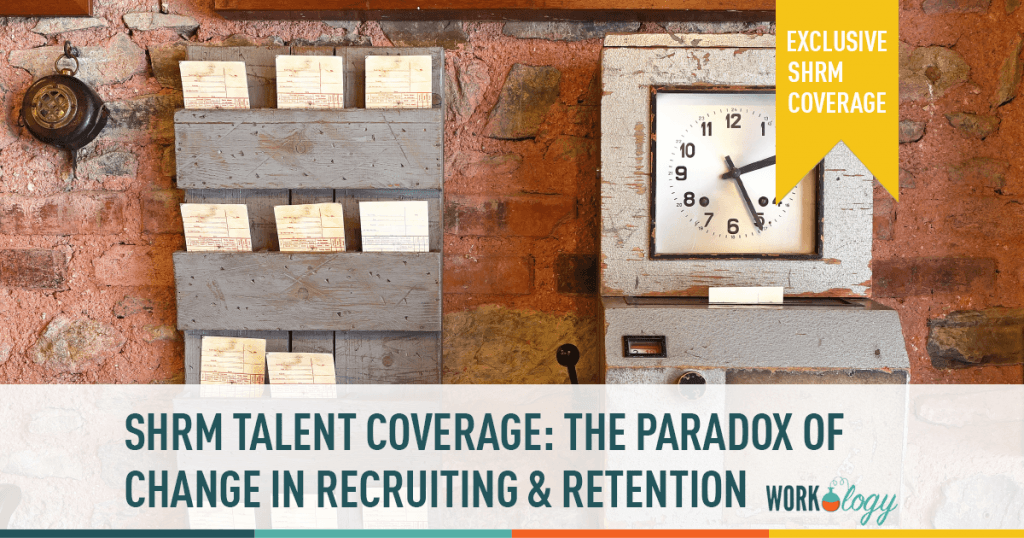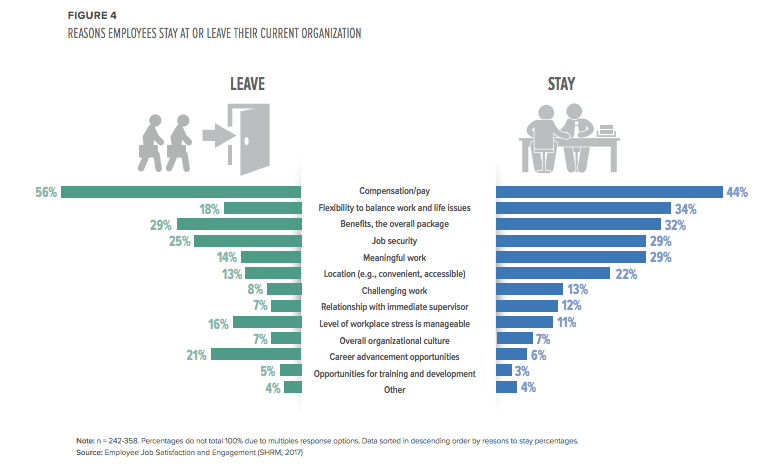At the SHRM Talent conference this week in Chicago, the subject of employee engagement and retention are a popular one especially in this competitive job market. Recruiters are actively pursuing candidates regardless of their interest level in a job or if they are active in the job search which means that employers need to be focused on retention and engagement efforts if they want to keep their best talent at their organization.
#SHRMTalent: The Paradox of Choice in Recruiting & Retention
SHRM’s recent employee engagement research found three areas that create a basic framework for employee engagement:
– Conditions for employment – which includes the workplace and environment and the work itself
– An employee’s connection to their work
– An employee’s connection to their work colleagues
While this year’s survey shows that employees remain moderately engaged at their workplace. I’ll share a graphic of the reasons employees stay and leave organizations from the SHRM study later below. I find the survey findings interesting because engagement is a feeling. It’s personal, unique and fluid to that employee. Engagement is a moving target because it is always changing and can be influenced by so many outside factors other than simply your job.
Recruiting and Hiring as Marketing
As recruiting teams, we are getting not only more aggressive in our recruiting efforts but also savvier and strategic, treating our recruiting advertisements like traditional marketing campaigns. There is a science to driving interest, asking questions and positioning your organization as an employer of choice. It’s not unlike neuroscience or psychological marketing strategies driving consumers to purchase products they never knew they needed. Facebook does a great job of this using videos and targeting to drive consumers, telling a story, using our emotions and taking advantage of media.
As recruiters, we are working to do the same things. That’s a lot of what my talks at SHRM Talent are about. I’m discussing the digital tools and technologies used to engage and build relationships with targeted communities of candidates for the purposes of recruiting and hiring. The more awareness we create around employment opportunities for all organizations, employees are going to want to explore options because the information, resources and water cooler conversations are happening out there even without strategically placed recruiting advertising efforts. No different than the targeted Facebook ad or the those Buzzfeed cooking videos that get me excited about trying a new recipe and heading to the grocery store.
What’s interesting to me is that the employee engagement levels and the tools used to engage candidate prospects are relatively the same across the board. Employees will stay at organizations that offer these certain benefits, opportunities and workplace environments. And employees will jump ship to a new employer to try their luck at an organization who is offering these same things. Employee engagement is a moving target for most organizations. Engagement in itself is personal and unique to the employees themselves and unfortunately, most employee retention programs and workplace engagement strategies are developed for the masses and not customized for the individual employee.
The graphic you see above you is from the SHRM study. The results aren’t surprising. They are what I would expect. These key retention and turnover drivers are consistent within most organizations and yet engagement levels even in this strong economy haven’t moved significantly. Why is that?
Paradox of Choice in Recruiting and Retention
We are living in a Wal-Mart Super Center world of employment right now. Candidates have so many options they are unable to stay true to a single brand. It’s hard to choose the right company to work for when there are 25 different types of laundry detergent that all tell you they get your brights the brightest. We may stay true to our brand out of allegiance or our happiness with its performance We are happy with how our laundry detergent brand performs. We can also be paralyzed and unable to make a decision because of the fear and anxiety that we feel forcing us to make no decision. In 2004, Barry Schwartz an American psychologist called this a paradox of choice. This quote comes from his book also by the same name:
Autonomy and Freedom of choice are critical to our well being, and choice is critical to freedom and autonomy. Nonetheless, though modern Americans have more choice than any group of people ever has before, and thus, presumably, more freedom and autonomy, we don’t seem to be benefiting from it psychologically.
I find it ironic that in a world where we have so many choices for employment, we still have the engagement levels we do. Freedom and autonomy are supposed to increase our satisfaction and happiness and yet when it comes to our work, they are not. As recruiters, we need to make our efforts so targeted and refined that we engage the smallest and most qualified audience. According to the paradox of choice, if all employers actively engaged fewer candidates for opportunities, we would have happier and a more engaged workforce because there are fewer options for them to consider. And more importantly, there would be less likelihood of buyer’s remorse which is the likely reason you see a candidate who has jumped ship within the first 12 months. It wasn’t a right fit so they leave because the new job was worse than the old one.
Not everyone agrees with Schwartz’s school of thought but when it comes to the continued struggle in employee engagement and retention, I tend to think the fewer choices we have, the more satisfied we might be with our employment decisions. The same might be said for that hiring manager who never wants to commit to the best candidate for a job requisition. They are almost always torn worrying that a better candidate might be hiding behind application number 3,057, or 1,455. Isn’t that why we normally present our best 3 candidates because of the paradox of choice?
The two consistent themes to engagement and job satisfaction from the SHRM Study are fairness and openness. To me, this speaks to the power of relationships, personalization and specifically the workplace environment that is individualized and not painted with a broad brush. This is in direct conflict with many things we do in HR and recruitment. Our employees and candidates are individuals and yet we are focused on providing same and equal treatment when we should be doing the opposite.










